A Novel Graphical Targeting Technique for Optimal Allocation of Biomass Resources
Abstract
:1. Introduction
2. Problem Statement
- ▪
- Given a set of biomass sources i ∈ I. Each biomass type has its specific calorific value CVi, moisture content MCi and maximum availability Si.
- ▪
- The biomass sources are to be allocated to a set of biomass demands j ∈ J, which are power plants that require biomass for power generation. Each plant has its power output Pj that has to be fulfilled and can only handle a maximum capacity Dj of biomass.
3. Power Generation Model
Graphical Targeting Method
- A demand composite curve is first plotted on a power versus biomass capacity diagram (Figure 2a). The demand composite curve consists of the individual power plants that require biomass feed. Its horizontal distance represents the maximum total capacity of biomass that can be handled by these plants (ΣjDj), while its vertical distance represents their total power output (ΣjPj). Note that the individual segments in the demand composite curve correspond to power plant j (PP1 and PP2 in Figure 2a) which have been arranged according to the descending order of their power generation factor Cj (slope of the segment), the latter may be calculated using Equation (4).
- A source composite curve is next plotted on the same diagram as the demand composite curve, but is interpreted as power versus biomass handling capacity. The source composite curve may consist of one or more biomass sources, plotted according to the descending order of their power generation factor Ci (determined using Equation (6)). The BEPD is considered feasible when the source composite curve is located to the left of the demand composite curve and has, at least, the same vertical distance as the latter, such as that shown in Figure 2a. For this case, the source composite curve will generate a total power of ΣiPi, which matches the total output of the power plants (ΣjPj), and yet is lower than their maximum total handling capacity (i.e., ΣiSi ≤ ΣjDj).
- In cases where the source composite curve is found on the right and/or below the demand composite curve (such as that in Figure 2b), the BEPD is considered infeasible. Additional biomass with a higher power generation factor is to be supplied in order to restore its feasibility. As shown in Figure 3a, additional biomass with higher power generation factor is added; the latter is characterised by its locus of steeper slope. The source composite curve is then slid along this locus until it stays completely above and to the left of the demand composite curve and touches the former at the pinch. The opening on the left of the BEPD represents the minimum amount of additional biomass to be added (FBIOM). Its amount is to be minimised, as it is usually more expensive due to its higher power generation factor. Conversely, the opening on the right of the BEPD represents excess biomass (FEXC) that is beyond the handling capacity of the power plant. This excess biomass can be utilised for other commercial purposes. Note that there are cases where the source composite curve is comprised of several source segments. Besides, there are also cases where the pinch occurs in the middle section of the composite curves. Both of these cases are shown in Figure 3b. The same principles are applied here. The source composite curve is slid along the locus of biomass with higher power generation factor, until it stays completely above and to the left of the demand composite curve. The composite curves touch each other at the pinch. For this case, excess biomass (FEXC) is determined from the horizontal distance of the segment extended beyond the demand composite curve (represented by the rectangular box in Figure 3b).
4. Illustrative Examples
4.1. Example 1—Single Biomass Source
4.2. Example 2—Multiple Biomass Sources
5. Practical Implications
6. Conclusions
Funding
Institutional Review Board Statement
Informed Consent Statement
Data Availability Statement
Acknowledgments
Conflicts of Interest
Appendix A—Superstructural Model
References
- IEA. Global Energy Review 2021. Assessing the Effects of Economic Recoveries on Global Energy Demand and CO2 Emissions in 2021; IEA: Paris, France, 2021. [Google Scholar]
- Ng, W.P.Q.; How, B.S.; Lim, C.H.; Ngan, S.L.; Lam, H.L. Biomass supply chain synthesis and optimization. In Value-Chain of Biofuels; Yusup, S., Rashidi, N.A., Eds.; Elsevier: Amsterdam, The Netherlands, 2021; pp. 445–479. [Google Scholar] [CrossRef]
- Lim, C.H.; Ngan, S.L.; Ng, W.P.Q.; How, B.S.; Lam, H.L. Biomass supply chain management and challenges. In Value-Chain of Biofuels; Yusup, S., Rashidi, N.A., Eds.; Elsevier: Amsterdam, The Netherlands, 2021; pp. 429–444. [Google Scholar] [CrossRef]
- Čuček, L.; Lam, H.L.; Klemeš, J.J.; Varbanov, P.S.; Kravanja, Z. Synthesis of regional networks for the supply of energy and bioproducts. Clean Technol Environ. Policy 2010, 12, 635–645. [Google Scholar] [CrossRef]
- Foo, D.C.Y.; Tan, R.R.; Lam, H.L.; Abdul Aziz, M.K.; Klemeš, J.J. Robust models for the synthesis of flexible palm oil-based regional bioenergy supply chain. Energy 2013, 55, 68–73. [Google Scholar] [CrossRef]
- Ling, W.C.; Verasingham, A.B.; Andiappan, V.; Wan, Y.K.; Chew, I.M.L.; Ng, D.K.S. An integrated mathematical optimisation approach to synthesise and analyse a bioelectricity supply chain network. Energy 2019, 178, 554–571. [Google Scholar] [CrossRef]
- Aranguren, M.; Castillo-Villar, K.K.; Aboytes-Ojeda, M. A two-stage stochastic model for co-firing biomass supply chain networks. J. Clean Prod. 2021, 319, 128582. [Google Scholar] [CrossRef]
- Mohd Yahya, N.S.; Ng, L.Y.; Andiappan, V. Optimisation and planning of biomass supply chain for new and existing power plants based on carbon reduction targets. Energy 2021, 237, 121488. [Google Scholar] [CrossRef]
- Duc, D.N.; Meejaroen, P.; Nananukul, N. Multi-objective models for biomass supply chain planning with economic and carbon footprint consideration. Energy Rep. 2021, 7, 6833–6843. [Google Scholar] [CrossRef]
- Foo, D.C.Y. Process Integration for Resource Conservation; CRC Press: Boca Raton, FL, USA, 2012. [Google Scholar] [CrossRef]
- El-Halwagi, M.M. Sustainable Design through Process Integration, 2nd ed.; Elsevier: Waltham, MA, USA, 2017. [Google Scholar]
- Linnhoff, B.; Townsend, D.W.; Boland, D.; Hewitt, G.F.; Thomas, B.E.A.; Guy, A.R.; Marshall, R.H. A User Guide on Process Integration for the Efficient Use of Energy; Institution of Chemical Engineers: Rugby, UK, 1982. [Google Scholar]
- Smith, R. Chemical Process Design and Integration, 2nd ed.; John Wiley & Sons, Inc.: Chichester, UK, 2016. [Google Scholar]
- Lam, H.L.; Varbanov, P.; Klemeš, J. Minimising carbon footprint of regional biomass supply chains. Resour. Conserv. Recycl. 2010, 54, 303–309. [Google Scholar] [CrossRef]
- Tan, R.R.; Bandyopadhyay, S.; Foo, D.C.Y. Graphical Pinch Analysis for Planning Biochar-Based Carbon Management Networks. Process Integr. Optim. Sustain. 2018, 2, 159–168. [Google Scholar] [CrossRef]
- Foo, D.C.Y. A Simple Mathematical Model for Palm Biomass Supply Chain. In Green Technologies for the Oil Palm Industry; Foo, D.C.Y., Aziz, M., Eds.; Springer: Singapore, 2019; pp. 115–130. [Google Scholar] [CrossRef]
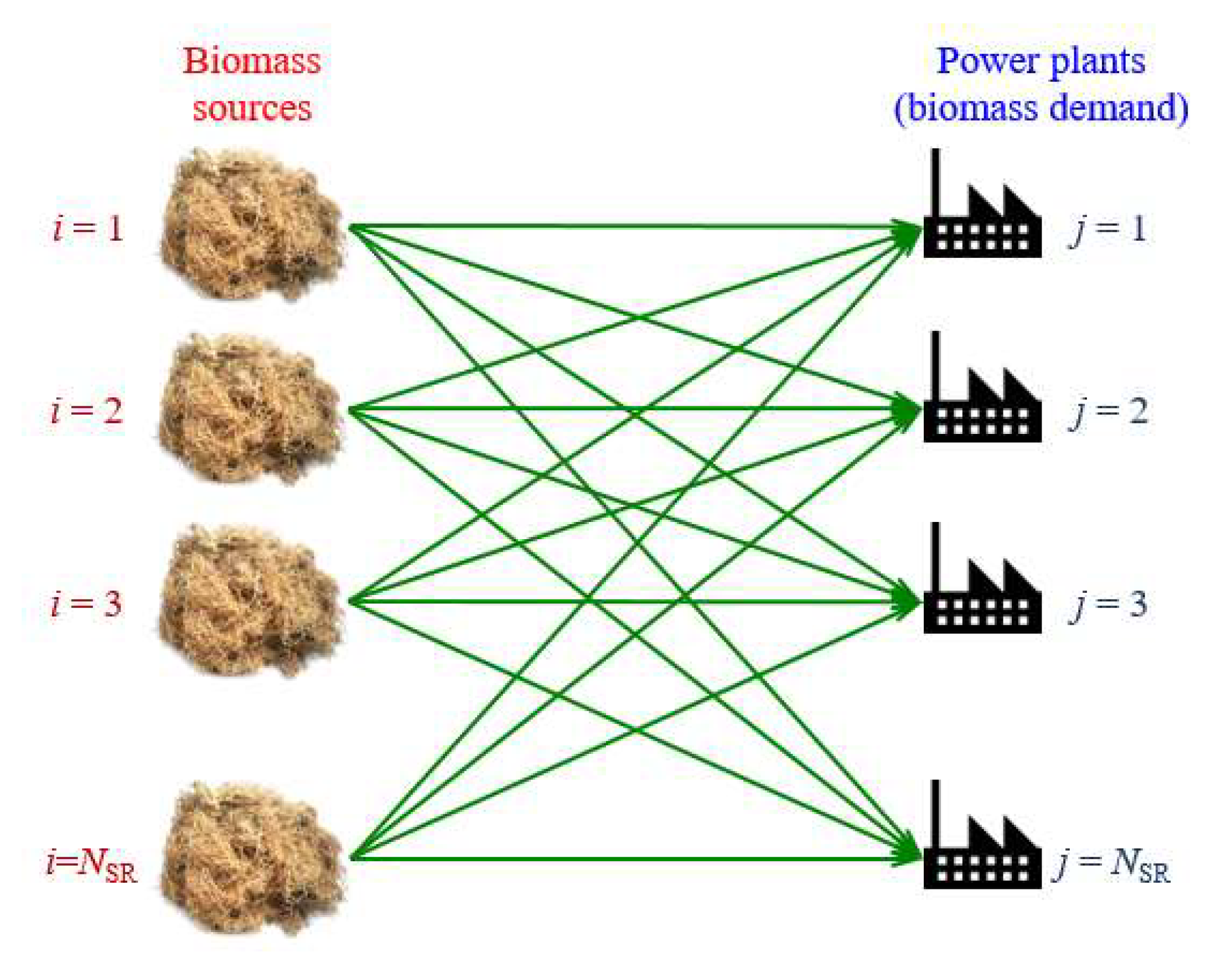
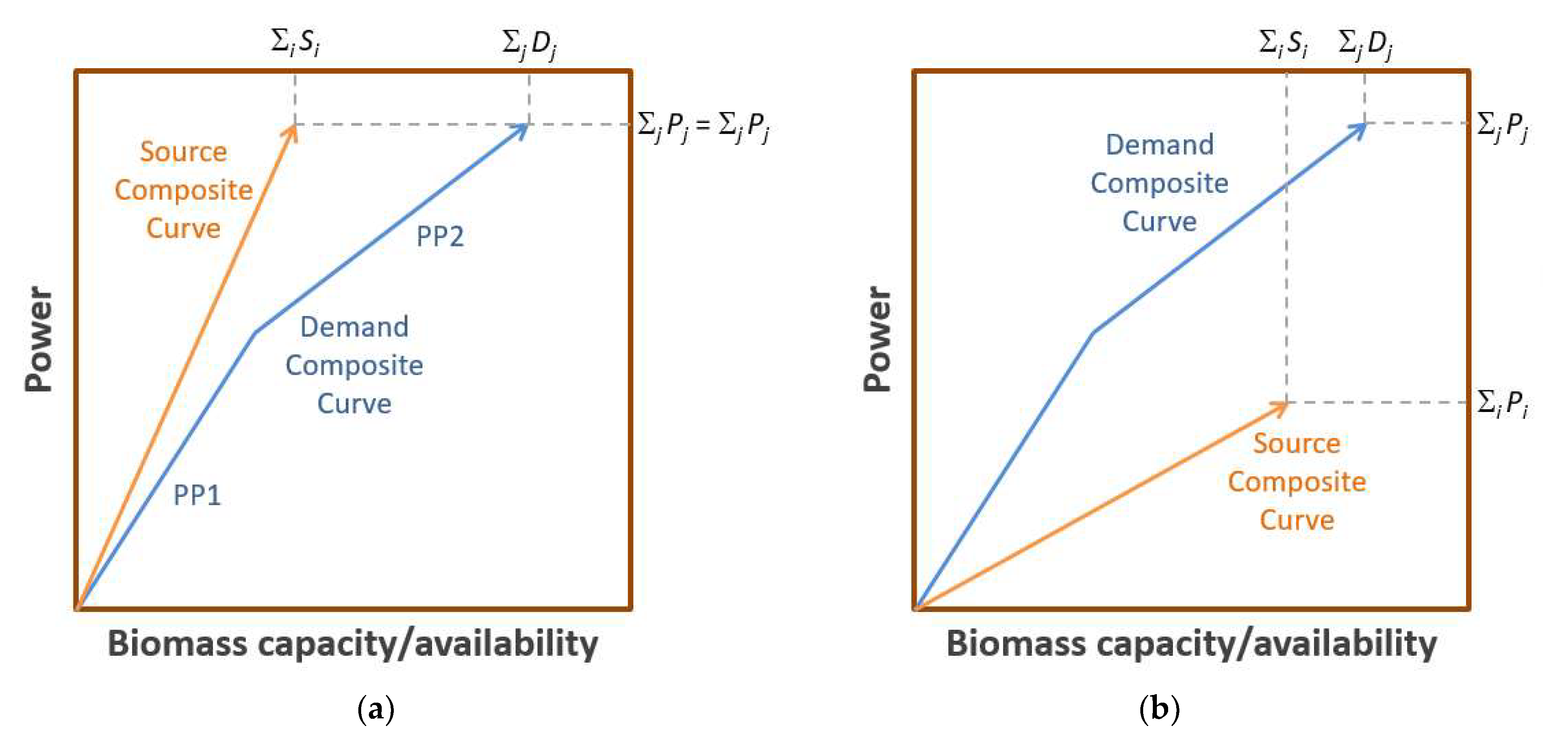
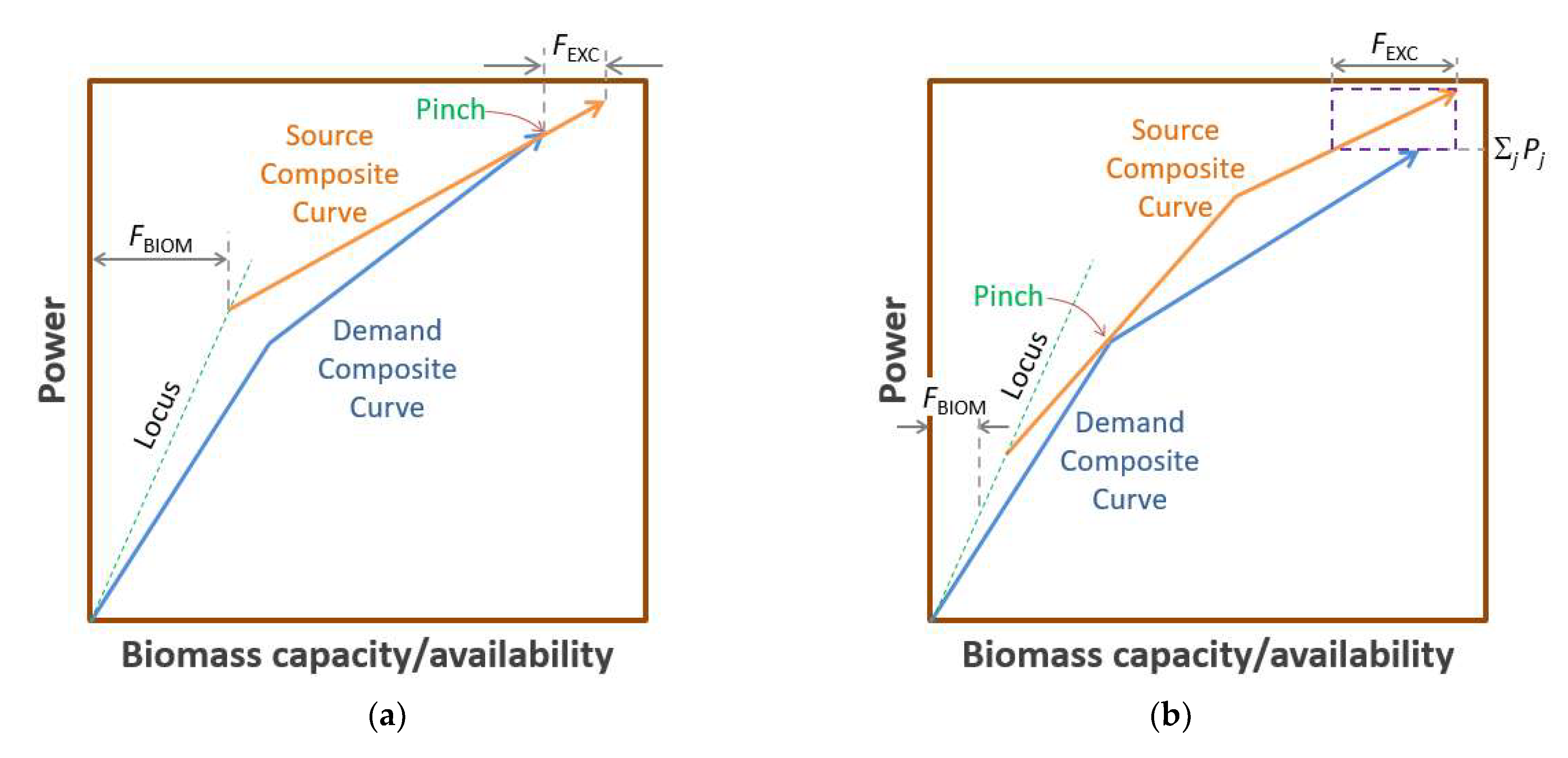

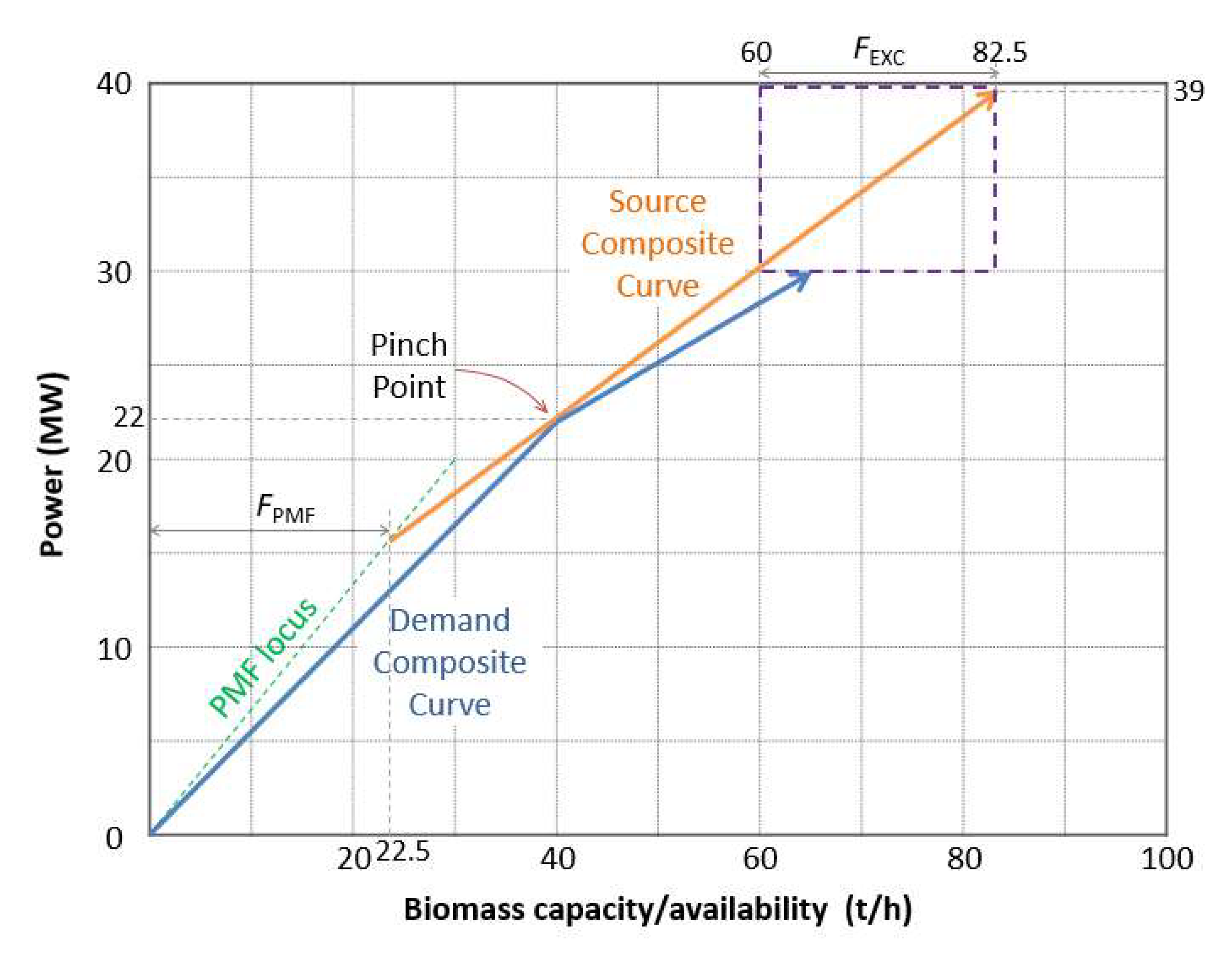
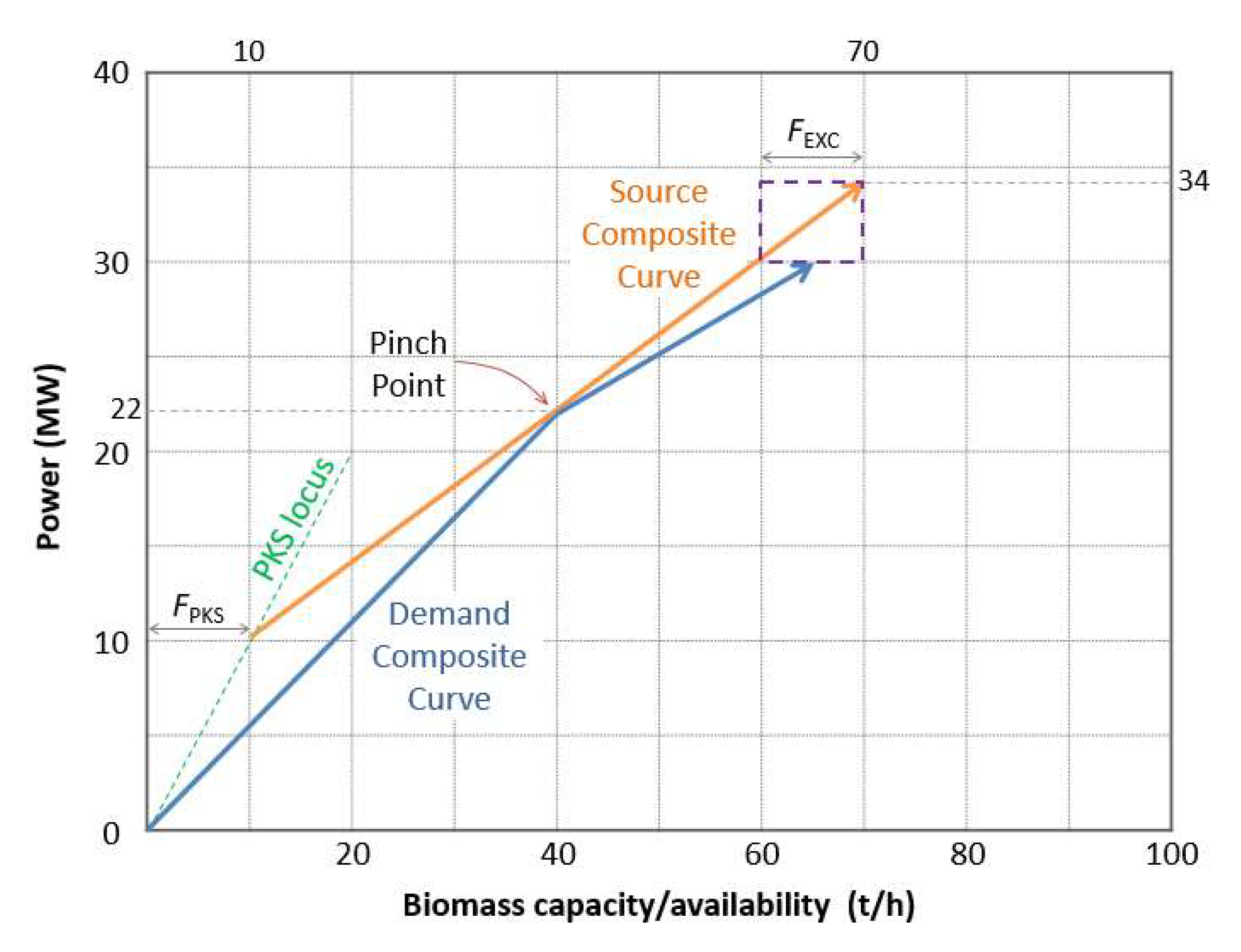



| Parameters | Values |
|---|---|
| Turbine | |
| 19.8% | |
| 3140 kg/kg steam | |
| Boiler | |
| 85% | |
| 2669 kJ/kg steam | |
| 19,000 kJ/kg biomass |
| Power Plants | Pj (MW) | MCBiom (%) | Dj (t/h) | Cj (MWh/t) |
|---|---|---|---|---|
| PP1 | 22 | 47.4 | 40 | 0.55 |
| PP2 | 8 | 69.4 | 25 | 0.32 |
| Total | 30 | 65 |
| Biomass Types | Si (t/h) | CVi (kJ/kg) | MCi (%) | Pi (MW) | Ci (MWh/t) |
|---|---|---|---|---|---|
| PKS | To be determined | 19,700 | 23 | To be determined | 1 |
| PMF | 19,000 | 36 | 0.67 | ||
| EFB | 60 | 18,700 | 61 | 24 | 0.4 |
| Power Plants | Pj (MW) | MCj (%) | Dj (t/h) | Cj (MWh/t) |
|---|---|---|---|---|
| PP1 | 8 | 49.0 | 15 | 0.53 |
| PP2 | 12 | 54.0 | 25 | 0.48 |
| PP3 | 10 | 60.0 | 24 | 0.42 |
| PP4 | 10 | 63.2 | 26 | 0.38 |
| Total | 40 | 90 |
| Scenario | Biomass Types | Si (t/h) | CVi (kJ/kg) | MCi (%) | Pi (MW) | Ci (MWh/t) |
|---|---|---|---|---|---|---|
| 1 | PKS | 40 | 19,700 | 23 | 40 | 1 |
| EFB | 100 | 18,700 | 61 | 40 | 0.4 | |
| 2 | PMF | To be determined | 19,000 | 36 | To be determined | 0.67 |
| EFB | 72.5 | 18,700 | 61 | 29 | 0.4 | |
| 3 | PKS | To be determined | 19,700 | 23 | To be determined | 1 |
| PMF | 18 | 19,000 | 36 | 12 | 0.67 | |
| EFB | 20 | 18,700 | 61 | 8 | 0.4 |
Publisher’s Note: MDPI stays neutral with regard to jurisdictional claims in published maps and institutional affiliations. |
© 2022 by the author. Licensee MDPI, Basel, Switzerland. This article is an open access article distributed under the terms and conditions of the Creative Commons Attribution (CC BY) license (https://creativecommons.org/licenses/by/4.0/).
Share and Cite
Foo, D.C.Y. A Novel Graphical Targeting Technique for Optimal Allocation of Biomass Resources. Processes 2022, 10, 905. https://doi.org/10.3390/pr10050905
Foo DCY. A Novel Graphical Targeting Technique for Optimal Allocation of Biomass Resources. Processes. 2022; 10(5):905. https://doi.org/10.3390/pr10050905
Chicago/Turabian StyleFoo, Dominic C. Y. 2022. "A Novel Graphical Targeting Technique for Optimal Allocation of Biomass Resources" Processes 10, no. 5: 905. https://doi.org/10.3390/pr10050905
APA StyleFoo, D. C. Y. (2022). A Novel Graphical Targeting Technique for Optimal Allocation of Biomass Resources. Processes, 10(5), 905. https://doi.org/10.3390/pr10050905






